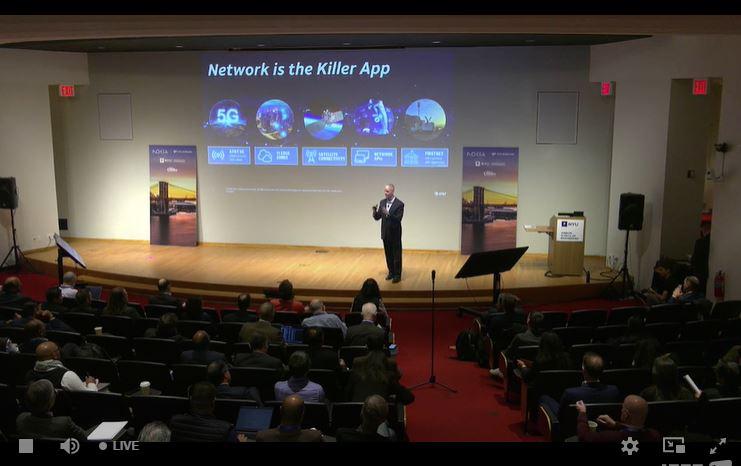The talk du jour is mostly 6G at the Brooklyn 6G Summit, but spectrum is at the center of it all and one keynote speaker this week took the opportunity to let policy makers know that he thinks the Citizens Broadband Radio Service (CBRS) is a failed experiment.
Chris Sambar, EVP for Technology at AT&T, pointed to a chart showing licensed and unlicensed mid-band spectrum country by country, with the U.S. down at No. 10 in the licensed department.
“That’s a problem,” he said, adding that “we’ve been showing this” all over Washington, D.C., helping people understand that “if we don’t allocate more mid-band spectrum and move ourselves higher up that stack and get closer to 1500 megahertz of mid-band spectrum, we’re going to start to see the wireless networks in the U.S. suffer. The use cases that are coming won’t perform if we don’t have enough spectrum.”
Looking at the charts, one might get the idea that the U.S. is winning the race in unlicensed mid-band spectrum, “but I don’t know that that’s a race we want to win” because that hasn’t worked out nearly as well as people in Washington, D.C., and elsewhere had hoped, he said.
He used CBRS as a classic example. There are thousands of small cells in the AT&T network that are using CBRS “and if I could snap my fingers today and pull all of them out and put mid-band spectrum in place of that CBRS, I would do it … That experiment has not worked out well.”
Cable companies are using CBRS to offload their MVNO traffic, and they’re going to find the same thing that AT&T did – that it’s not a very good idea, he said. “I don’t care, because it’s cable, but at the same time, I’m a little sad that this is where our nation is and I think we can do better than this.”
Power levels
During a Q&A after his presentation, analyst Joe Madden of Mobile Experts asked whether the problem with CBRS is due to the power levels, the shared nature of it, the complexity of the Spectrum Access System (SAS) or something else.
Sambar said it’s mainly the power issue. They can use CBRS when they run into spectrum constraints, but that doesn’t take full advantage of the infrastructure that’s deployed so then they have to consider deploying more infrastructure with full power with the spectrum bands that they have.
Sharing spectrum is not necessarily an issue, he said, noting how AT&T is working closely with the Department of Defense (DoD) on the 3.45 GHz spectrum.
“I would say it’s mainly the power” that’s the issue. “We can share spectrum but it needs to be at full power so we get full propagation and benefit with our infrastructure,” Sambar said.
His comments came a day after New America Open Technology Institute hosted “The Future of Private Networks” event in Washington, D.C., where CBRS was discussed as an innovative spectrum sharing framework.
Initially, wireless carriers opposed the sharing approach the FCC devised for CBRS but some of them – notably, not AT&T – ended up participating in the auction of Priority Access Licenses (PALs), and they’re all free to use the unlicensed General Authorized Access (GAA) portion of the band.
CBRS returned to the headlines in 2022 after CTIA commissioned a report that concluded the band doesn’t live up to the hype and shouldn’t be a model for future spectrum policy. They don’t want similar models in the lower 3 GHz band, for example, whereas the Brattle Group released a study in September concluding that CBRS-style sharing can foster innovation and novel uses, such as in private networks.
What about 6G?
5G already has brought increased use of mobile networks. The average usage at a game at AT&T Stadium is about 21 terabits; this year’s Super Bowl was a little bit more than that, he said. However, the record at any stadium in the U.S. so far this year was a Taylor Swift concert, where the average usage was 29 terabits, Sambar said.

Operators are being told that 6G should enable up to 10x increase in usage on the networks. But the industry has questions about what 6G is going to enable and what it’s going to cost, he said.
For example, if an operator buys spectrum at auction and it’s deployed in the network, that could cost $6 billion to $8 billion. On top of that, a new spectrum band requires a new radio, antenna, cabling work, augmentation to the transport link and more. That adds more costs to the equation, and that’s just one band of spectrum.
“When you see in the wireless industry that it seems like investment is in a trough right now, that has a lot to do with it. We’re getting a little bit worn out with the economics of the industry. It’s a very healthy and vibrant industry. We’re seeing that in the earnings releases from the three mobile operators just recently. But at the same time, the capital investments – they have to be logical. We have to have clear line of sight to what the consumer use cases are for those capital investments,” he said.
AT&T just spent about $40 billion in the last two years on mid-band spectrum alone. Verizon spent over $50 billion. T-Mobile acquired another operator to get its spectrum war chest. These are all expensive endeavors and it can’t be a bottomless pit industry, he said.
However, he also discussed some of the expected advancements in 6G, particularly for the network, such as artificial intelligence and machine learning that can save operators a lot money and enable better self-optimization in the network than what’s currently available.
